

在鸿蒙系统中移植Paho-MQTT实现MQTT协议的详细教程
电子说
描述
MQTT 是当前最主流的物联网通信协议,需要物联网云平台,例如华为云、阿里云、移动 OneNET 都支持 MQTT。而 Hi3861则是一款专为 IoT 应用场景打造的芯片。
本节主要讲如何在鸿蒙系统中通过移植第 3 方软件包 Paho-MQTT 去实现 MQTT 协议功能,最后会给出测试验证。为后续的物联网项目打好基础。
友情预告,本节内容较多,源码也贴出来了,大家最好先看一遍,然后再操作一次。
相关源码已经打包上传,顺便上传了一个测试 OK 的固件,大家可以直接下载附件直接测试。解压后会得到 5 个压缩包,继续解压即可:
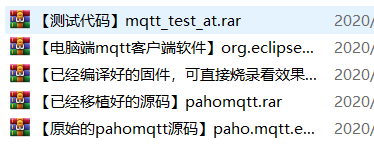
MQTT 介绍
MQTT 全称为 Message Queuing Telemetry Transport(消息队列遥测传输)是一种基于发布/订阅范式的二进制“轻量级”消息协议,由 IBM 公司发布。针对于网络受限和嵌入式设备而设计的一种数据传输协议。
MQTT 最大优点在于,可以以极少的代码和有限的带宽,为连接远程设备提供实时可靠的消息服务。
作为一种低开销、低带宽占用的即时通讯协议,使其在物联网、小型设备、移动应用等方面有较广泛的应用。
MQTT 模型如图所示:
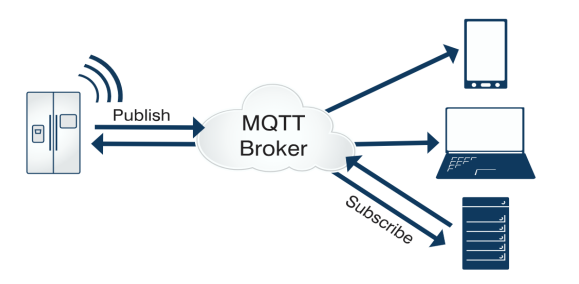
更多 MQTT 协议的介绍见上篇文章:MQTT 协议开发入门。
移植 Paho-MQTT 软件包
下载 paho mqtt 软件包,添加到鸿蒙代码中
paho mqtt-c 是基于 C 语言实现的 MQTT 客户端,非常适合用在嵌入式设备上。
首先下载源码:
https://github.com/eclipse/paho.mqtt.embedded-c 下载之后解压,会得到这么一个文件夹:
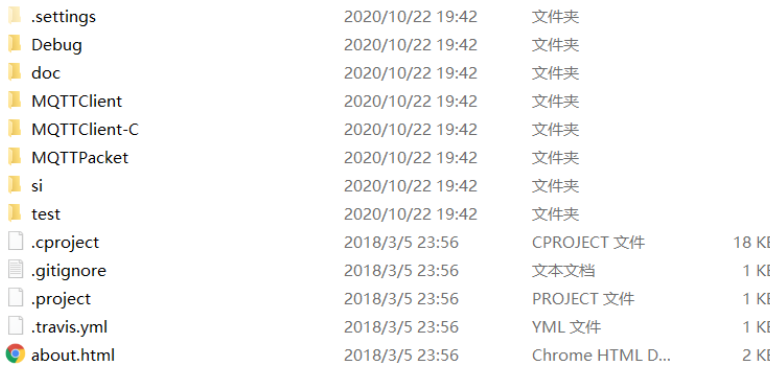
我们在鸿蒙系统源码的 third_party 文件夹下创建一个 pahomqtt 文件夹,然后把解压后的所有文件都拷贝到 pahomqtt 文件夹下。
目录结构大致如下:
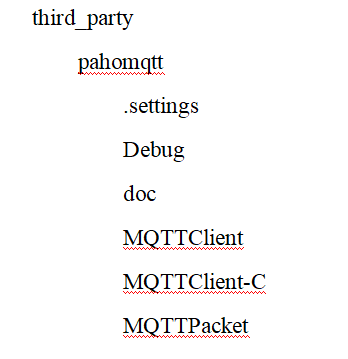
下一步,我们在 pahomqtt 文件夹下面新建 BUILD.gn 文件,用来构建编译。
其内容如下:
# Copyright (c) 2020 Huawei Device Co., Ltd. # Licensed under the Apache License, Version 2.0 (the "License"); # you may not use this file except in compliance with the License. # You may obtain a copy of the License at # # http://www.apache.org/licenses/LICENSE-2.0 # # Unless required by applicable law or agreed to in writing, software # distributed under the License is distributed on an "AS IS" BASIS, # WITHOUT WARRANTIES OR CONDITIONS OF ANY KIND, either express or implied. # See the License for the specific language governing permissions and # limitations under the License. import("//build/lite/config/component/lite_component.gni") import("//build/lite/ndk/ndk.gni") config("pahomqtt_config") { include_dirs = [ "MQTTPacket/src", "MQTTPacket/samples", "//vendor/hisi/hi3861/hi3861/third_party/lwip_sack/include", "//kernel/liteos_m/components/cmsis/2.0", ] } pahomqtt_sources = [ "MQTTPacket/samples/transport.c", "MQTTPacket/src/MQTTConnectClient.c", "MQTTPacket/src/MQTTConnectServer.c", "MQTTPacket/src/MQTTDeserializePublish.c", "MQTTPacket/src/MQTTFormat.c", "MQTTPacket/src/MQTTPacket.c", "MQTTPacket/src/MQTTSerializePublish.c", "MQTTPacket/src/MQTTSubscribeClient.c", "MQTTPacket/src/MQTTSubscribeServer.c", "MQTTPacket/src/MQTTUnsubscribeClient.c", "MQTTPacket/src/MQTTUnsubscribeServer.c", ] lite_library("pahomqtt_static") { target_type = "static_library" sources = pahomqtt_sources public_configs = [ ":pahomqtt_config" ] } lite_library("pahomqtt_shared") { target_type = "shared_library" sources = pahomqtt_sources public_configs = [ ":pahomqtt_config" ] } ndk_lib("pahomqtt_ndk") { if (board_name != "hi3861v100") { lib_extension = ".so" deps = [ ":pahomqtt_shared" ] } else { deps = [ ":pahomqtt_static" ] } head_files = [ "//third_party/pahomqtt" ] }
让 hi3861编译的时候,编译 paho mqtt软件包
打开 vendorhisihi3861hi3861BUILD.gn 文件。
在 lite_component("sdk") 中增加 "//third_party/pahomqtt:pahomqtt_static"。
修改后文件内容如下:
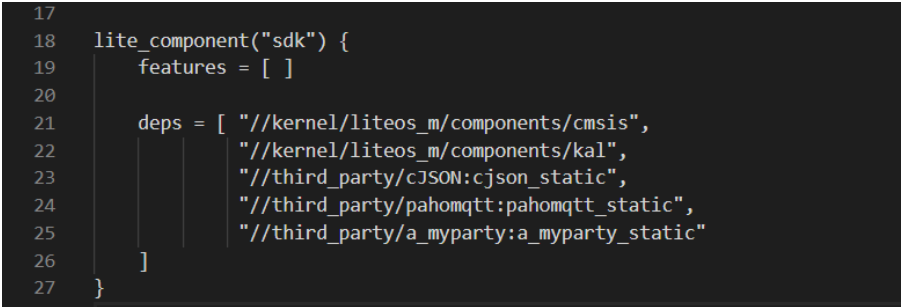
完成以上修改后,就可以开始编译了,然而很不幸的...你会发现好多编译报错。
不过没事,我们来一个一个解决。
移植,修改编译报错
打开 third_partypahomqttMQTTPacketsamples ransport.c 文件,这个文件也是我们主要移植的文件,我们需要实现 socket 相关的操作,包括发送、接收数据。
其实移植就 3 步:
①首先我们导入几个头文件:
#include "lwip/ip_addr.h" #include "lwip/netifapi.h" #include "lwip/sockets.h" ②其次修改 transport_sendPacketBuffer 函数,内容修改后如下:int transport_sendPacketBuffer(int sock, unsigned char* buf, int buflen) { int rc = 0; rc = send(sock, buf, buflen, 0); return rc; }
③后面编译的时候会报错说 close 函数不存在,我们修改 transport_close 函数,修改后内容如下:
int transport_close(int sock) { int rc; rc = shutdown(sock, SHUT_WR); rc = recv(sock, NULL, (size_t)0, 0); rc = lwip_close(sock); return rc; }
④修改完 transport.c 文件后,大家编译的时候估计会遇到很多编译错误,都是某个局部变量未使用那种,大家可以修改就行。
类似于这样的,提示 buflen 未使用的错误,大家只需要在代码中随便写个buflen = buflen; 即可。

编写测试代码
测试代码比较好写。主要是 3 个文件,内容我都贴出来了:
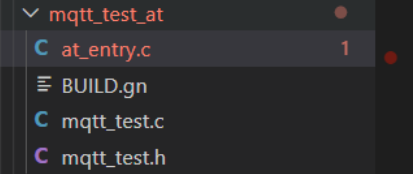
①BUILD.gn 文件内容
# Copyright (c) 2020 Huawei Device Co., Ltd. # Licensed under the Apache License, Version 2.0 (the "License"); # you may not use this file except in compliance with the License. # You may obtain a copy of the License at # # http://www.apache.org/licenses/LICENSE-2.0 # # Unless required by applicable law or agreed to in writing, software # distributed under the License is distributed on an "AS IS" BASIS, # WITHOUT WARRANTIES OR CONDITIONS OF ANY KIND, either express or implied. # See the License for the specific language governing permissions and # limitations under the License. static_library("mqtt_test_at") { sources = [ "mqtt_test.c", "at_entry.c" ] include_dirs = [ "//utils/native/lite/include", "//kernel/liteos_m/components/cmsis/2.0", "//base/iot_hardware/interfaces/kits/wifiiot_lite", "//vendor/hisi/hi3861/hi3861/third_party/lwip_sack/include", "//foundation/communication/interfaces/kits/wifi_lite/wifiservice", "//third_party/pahomqtt/MQTTPacket/src", "//third_party/pahomqtt/MQTTPacket/samples", "//vendorhisihi3861hi3861componentsatsrc" ] }
②at_entry.c 文件主要是注册了一个 AT 指令,后面大家可以使用 AT+MQTTTEST 指令来测试 MQTT 功能
代码内容如下:
#include
③mqtt_test.c 文件则是编写了一个简单的 MQTT 测试代码,具体代码讲解,后面会重新开一篇
其中测试用的 mqtt 服务器是我自己的服务器:106.13.62.194,大家也可以改成自己的,也可以直接用我个人的 mqtt 服务器。
#include
mqtt_test.h 文件内容:
#ifndef __MQTT_TEST_H__ #define __MQTT_TEST_H__ void mqtt_test(void); #endif /* __MQTT_TEST_H__ */
到这里就完成了代码部分,可以开始编译了。
MQTT 实验
这里我们需要先下载一个 Windows 电脑端的 MQTT 客户端,这样我们就可以用电脑订阅开发板的 MQTT 主题信息了。
电脑版的 mqtt 客户端下载链接:
https://repo.eclipse.org/content/repositories/paho-releases/org/eclipse/paho/org.eclipse.paho.ui.app/1.1.1/ 我们选择这一个:

弄完后打开软件,按图操作:
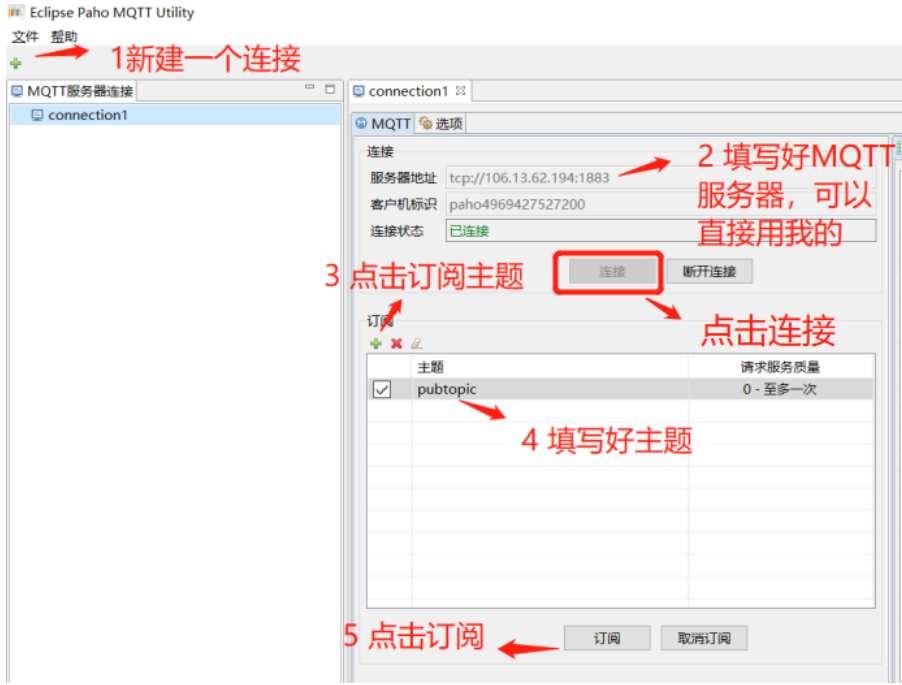
操作完后,我们把编译后程序烧写到开发板,输入如下串口指令,让开发板连接上网络,因为 MQTT 功能需要网络支持。
输入如下串口指令:
AT+STARTSTA 开启STA模式 AT+CONN="12-203",,2,"07686582488" 连接到路由器,注意wifi热点名和密码用自己的 AT+DHCP=wlan0,1 获取IP地址 AT+IFCFG 打印查看IP地址 串口指令的应答应该如下:
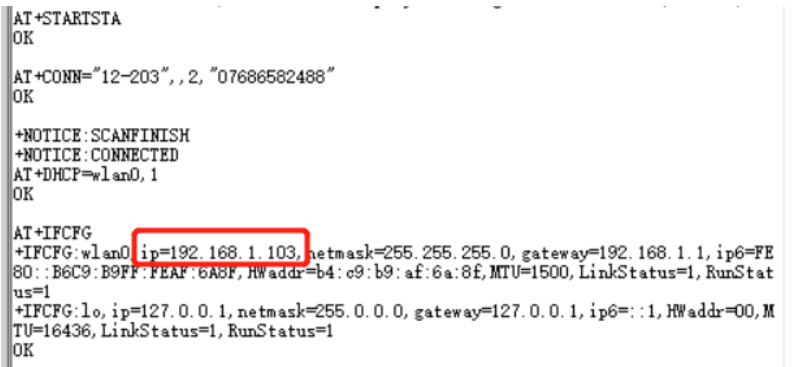
成功连接上路由器后,请确保路由器是可以上网的。然后我们输入我们的 MQTT 测试的 AT 指令:AT+MQTTTEST。
应该可以看到如下打印:

此时我们去查看 我们电脑端的 MQTT 客户端软件,可以看到右边已经有接收 MQTT 信息了,主题未 pubtopic,消息内容为 hello HarmonyOS ! 说明实验成功。

总结
这一次的内容比较多,其中总结起来就 4 步:
添加第三方软件包 paho mqtt,关于如何添加第3方软件包,我之前有一篇文章已经讲了。可以参考:如何往鸿蒙系统源码中添加第三方软件包。
移植 paho mqtt。
编写测试代码,这里我们用的是注册 AT 指令的方式,方便大家使用AT指令测试。
测试,这里用电脑装 mqtt 客户端程序,去验证。
责任编辑:PSY
原文标题:如何在鸿蒙系统中移植Paho-MQTT实现MQTT协议
文章出处:【微信公众号:HarmonyOS技术社区】欢迎添加关注!文章转载请注明出处。
-
paho-mqtt pipe和socket同时发送会导致pipe数据丢失怎么解决?2025-10-10 109
-
使用paho-mqtt里例程连接服务器失败怎么解决?2025-09-18 167
-
paho-mqtt模块实战2023-09-20 2239
-
如何使用Rust语言和paho-mqtt模块实现MQTT协议2023-09-19 2712
-
【Linux篇】Paho-MQTT-C移植2023-05-05 4581
-
paho-mqtt重连后AT发送会报错是什么原因?2023-01-10 778
-
基于Eclipse paho-mqtt源码包的MQTT客户端设计(上)2022-08-04 4122
-
怎样使用micropython去实现mqtt的协议测试呢2022-03-24 1494
-
如何使用paho-mqtt框架实现温湿度数据的实时显示?2021-10-08 1802
-
【直播预热】Harmony MQTT/CoAP应用指南——火热报名中2020-12-09 2365
-
【HarmonyOS HiSpark Wi-Fi IoT套件】如何在鸿蒙系统中移植 Paho-MQTT 实现MQTT协议2020-11-03 4056
-
【HarmonyOS】在鸿蒙开发板上使用MQTT协议、OneNET实现第一个物联网项目2020-10-26 2264
-
在鸿蒙开发板上使用MQTT协议、OneNET实现第一个物联网项目2020-10-25 3687
-
如何在鸿蒙系统中移植 Paho-MQTT 实现MQTT协议2020-10-23 4545
全部0条评论

快来发表一下你的评论吧 !

